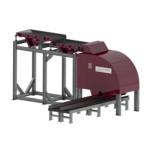Sense2Sort: New Era in Metal Recycling
August 16, 2016
Sense2Sort XRF and LIBS technology outshine common sensor based sorting solutions
Sensor based sorting (SBS) equipment has become well established in recycling since their first introduction in the 1990’s, but now the time has come that SBS suppliers have nothing dramatically new to bring onto the market. Granted, there have been minor improvements in old technology’s performance, or there is re-packaging and other cosmetic changes to give the appearance of having something new. This is not the case for Sense2Sort. We have paradigm-shifting technology that advances the downstream sorting process to address the future needs of the scrap consumers.
We are proud to show up with a real and significant step forward. It has become possible to analyze a particle‘s elemental composition by chemical content. Since introducing our S2S XRF-Sense in 2006 for the first time, the XRF technology has been continually redesigned thereby increasing processing speed; improving sorting qualities; hardening components for maximum lifetime; and perfecting the operating software and processing algorithms. We are proud to offer our newest generation of S2S XRF-Sense to our customers. Users can truly benefit via raising their profitability in an eco-friendly and cost-efficient manner.
The XRF has marked the start of a new era in sorting and recycling, complimenting common sorting technologies and opening up new territories for scrap producers and consumers. It is a fact that XRF can increase scrap metal specificity following gross sorting methods such as float/sink or XRT.
Sense2Sort LIBS-Sense outshines everything.
However, XRF has one limited application and this is light metals. To address this, S2S introduces LIBS-based sensor sorting. LIBS outshines everything sensed so far and is a breakthrough in light metals identification and classification. Designed for difficult environments like material handling and recycling, S2S LIBS-Sense delivers precise readings of light metals and alloys which could not be automatically sorted before. This helps our customers to upgrade more of their product and raise profits.
The LIBS analyzers are designed to identify truly light elements (e.g. Li, B, Be, Na, Mg), and heavy metals simultaneously.
Taking the secondary smelting of aluminum as an example, S2S LIBS technology enables the classification of individual classes of wrought alloys like 1000 thru 7000 series according to their chemical composition. Contaminants like copper, brass or ferrous or even plastics can be separated easily. Separating alloys gives way to increased profits and reduced cost for operators and smelters.
Our expertise in SBS goes back to the start of it. We are true experts in this business and offer you complete systems that separate multiple fractions in one pass. With our high frequency lasers there is no need for any pre-cleaning of the material surface and we realize a thruput of 2-5t/hour. Sorting of scrap alloys with minor alloying elements based on 0.5% difference has been proven. Additionally, true sorting of wrought and cast Al alloys based on the Si chemistry is another strong application.
As leaders, we are not resting on our achievements. S2S is continually working and we will be at the forefront with more, new, recycling technologies in the future. Welcome to the new way of recycling metals–delivering a sorted product that is ready to melt. This makes sense.
info@sense2sort.com




